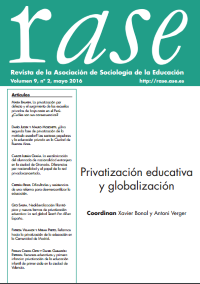Default Privatization and the emergence of low fee private schools in Perú. What are their consequences?
DOI:
https://doi.org/10.7203/RASE.9.2.8414Keywords:
Default school privatization, low-fee private schools, educational segregation Abstract
Abstract
Since the 1990s, when for-profit investment in education was liberalized, Perú has seen a constant growth in the supply and demand of private education services. This tendency has deepened in the last decade in a context of economic growth that has allowed many families to migrate to the private sector. The growth of the private education market has taken place, largely, behind the state, which regulates it minimally and ineffectively. The result is an extremely heterogeneous private education market, with an important sub-sector of low-fee –and often low-quality– private schools for low-income families. The paper analyses this process, explores poor families decisions to send their children to private schools and poses a series of considerations about the effects of the process of default privatization on the equity of the Peruvian education system.
 Downloads
Downloads
Downloads
Published
How to Cite
-
Abstract1356
-
PDF (Español)711
Issue
Section
License
![]()
This work is licensed under a Creative Commons Reconocimiento-NoComercial-CompartirIgual 4.0 Internacional.




